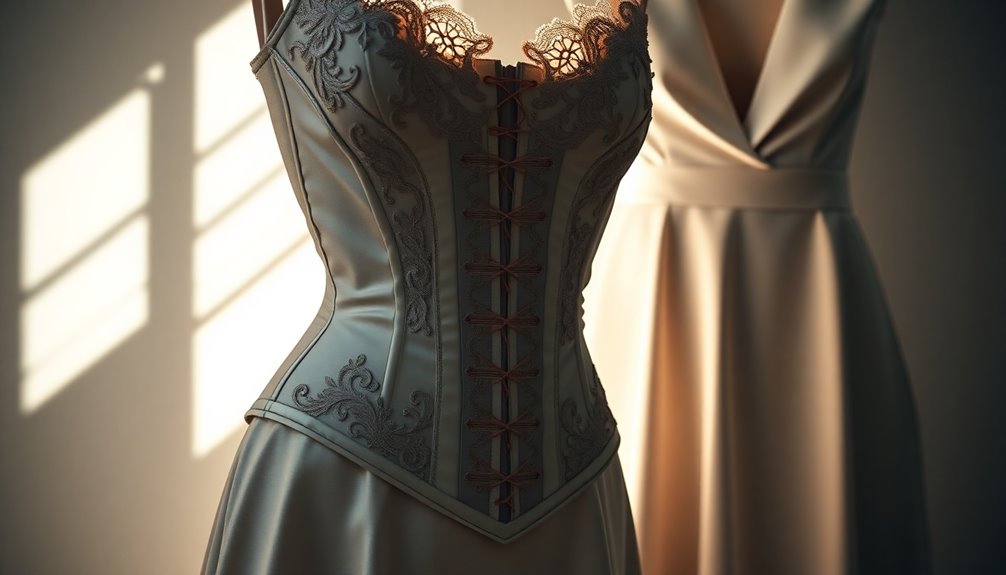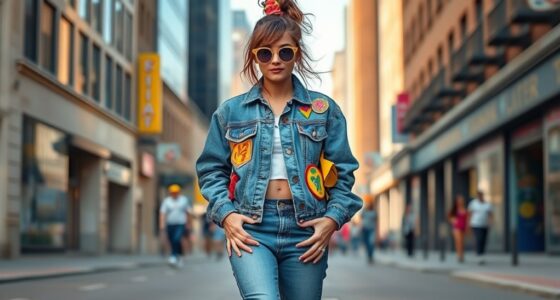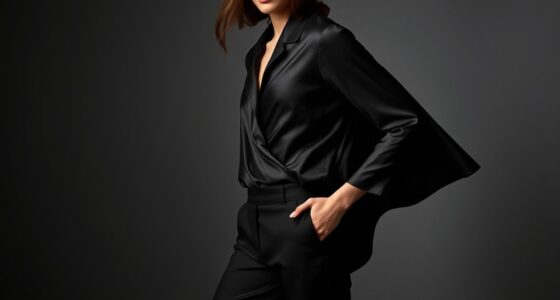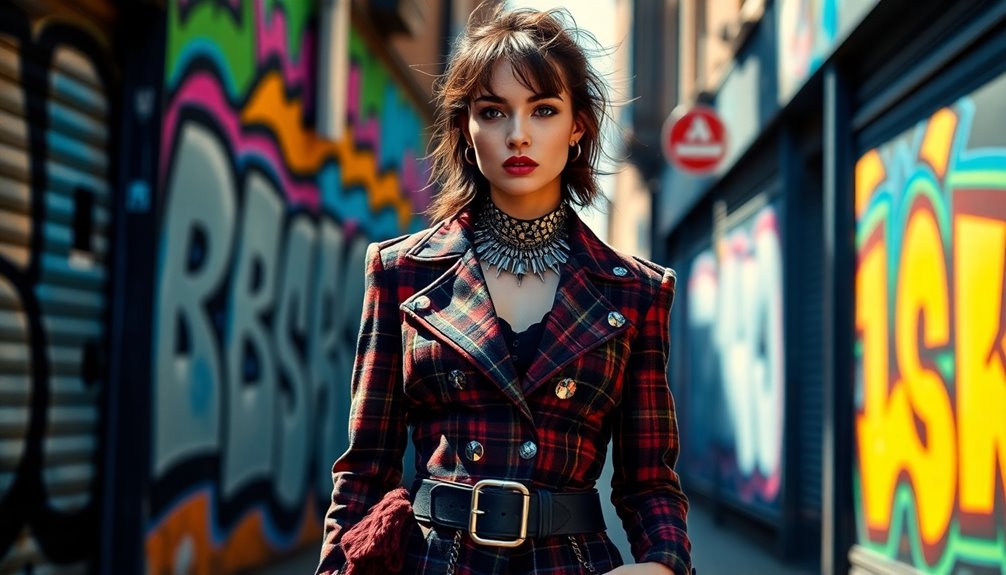Fashion's journey from corsets to modern styles reveals a powerful story of transformation. You'll notice how the early 1900s emphasized the S-curve silhouette, confining women to traditional roles. After WWI, clothing shifted towards comfort and simplicity, mirroring women's growing independence. The 1920s flapper dresses broke norms, while the 1960s miniskirts celebrated autonomy and self-expression. Economic factors and cultural shifts also shaped fashion, promoting sustainability and individual identity. Today, styles reflect both personal choices and societal nuances. There's more to uncover about this fascinating evolution, including how it continues to influence today's trends.
Key Takeaways
- Corsets, prevalent since ancient times, defined women's silhouettes until the early 20th century, emphasizing traditional femininity and modesty.
- The post-WWI era marked a shift towards comfort and simplicity in women's fashion, moving away from restrictive garments.
- The 1920s introduced looser silhouettes, such as flapper dresses, symbolizing women's independence and societal change.
- The 1960s and 70s saw the rise of miniskirts and pantsuits, representing liberation and self-expression in women's fashion.
- Fashion evolution reflects broader cultural shifts, including feminism and sustainability, emphasizing personal identity and ethical choices.
The Evolution of Fashion
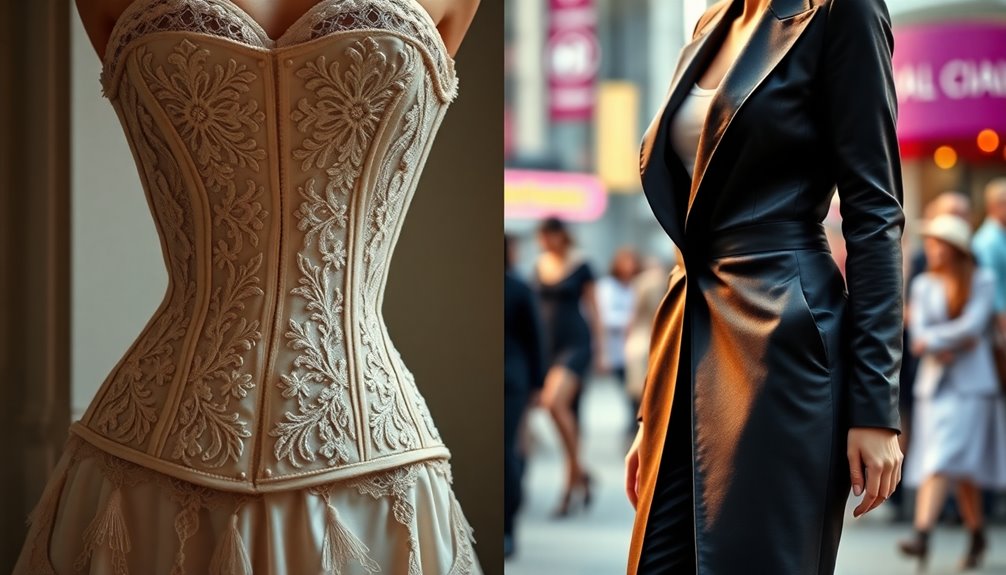
Throughout the centuries, the evolution of fashion has mirrored societal changes and women's roles, often reflecting their quest for liberation and identity.
You can trace this journey from the restrictive S-curve corsets of the early 1900s, which emphasized traditional femininity, to the post-WWI era, where simplicity and comfort took precedence.
As women entered the workforce during World War I, clothing transformed for practicality and ease of movement.
The 1920s introduced looser silhouettes, symbolizing newfound independence.
By the 1960s and 70s, miniskirts and pantsuits emerged, representing a bold statement of freedom.
Fashion became a powerful medium, intertwining with social movements, and showcasing how clothing choices can signal shifts in identity and empowerment.
Iconic Fashion Trends
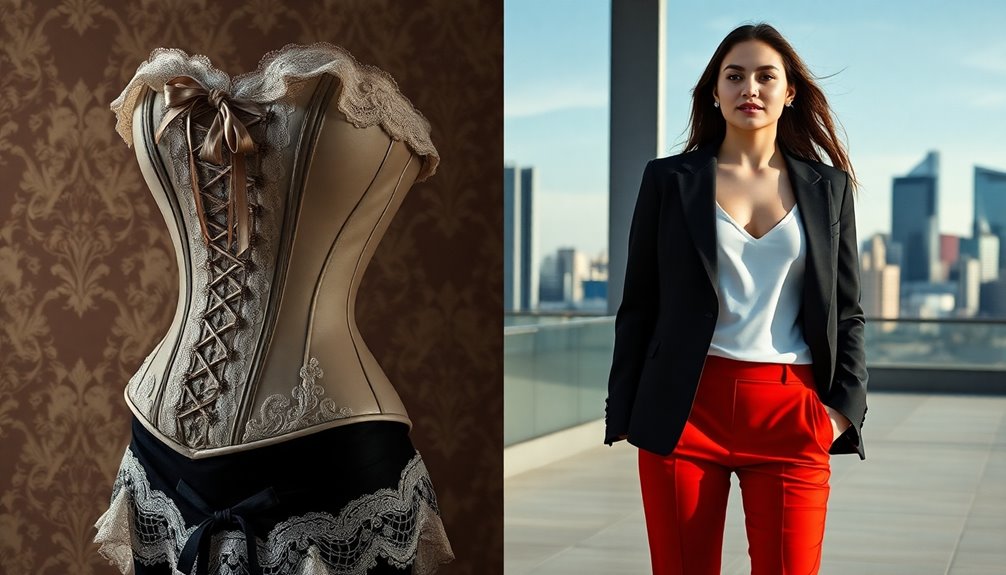
Iconic fashion trends have shaped cultures and defined eras, showcasing not just style but also the spirit of the times.
You've witnessed how styles evolve, often reflecting societal changes and cultural movements. From the flapper dresses of the 1920s to the bold patterns of the 1970s, each trend tells a story.
Consider these defining moments:
- The Little Black Dress, a timeless staple introduced by Coco Chanel, symbolizes elegance and versatility.
- The miniskirt, emerging in the 1960s, revolutionized women's fashion, expressing freedom and rebellion.
- The supermodel era of the 1990s celebrated diversity and natural beauty, leaving a lasting impact on how we perceive femininity.
These trends not only influence what you wear but also how you express yourself.
Corset History and Changes
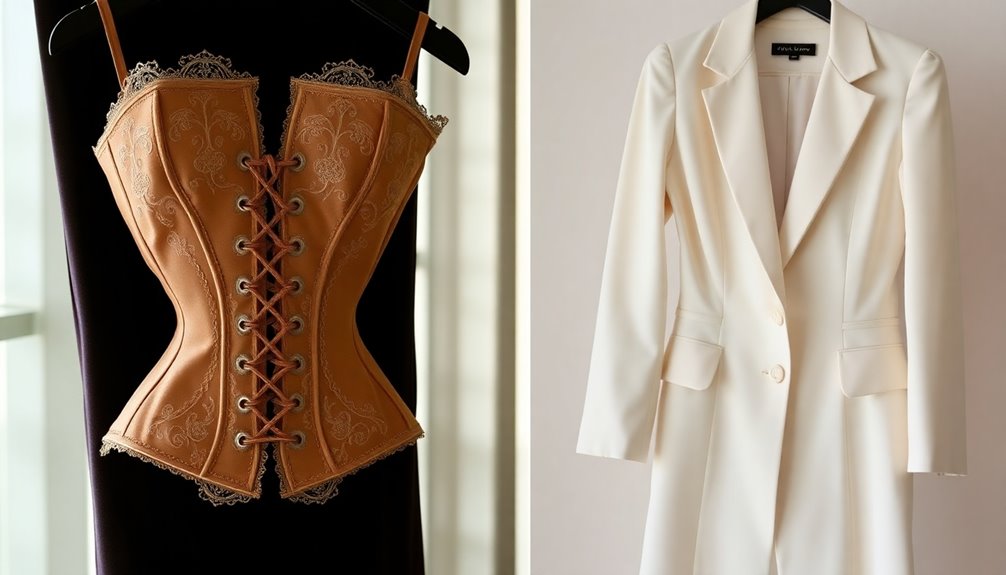
The corset's journey from ancient times to modern fashion reveals much about changing ideals of beauty and femininity. Originating in ancient civilizations, early corsets shaped the silhouette, becoming essential in French court fashion by the 1500s.
By the 1830s, the term "corset" gained popularity, with Victorian designs featuring up to 100 whalebones for structure. However, health concerns in the late 1800s prompted changes, leading to designs that valued comfort.
After World War I, women's roles evolved, and fashion shifted towards simplicity and practicality, moving away from restrictive garments. This transformation marked a significant cultural shift, reflecting women's growing independence and changing societal norms, ultimately paving the way for modern styles that prioritize comfort and self-expression over traditional constraints.
Economic Influences on Style
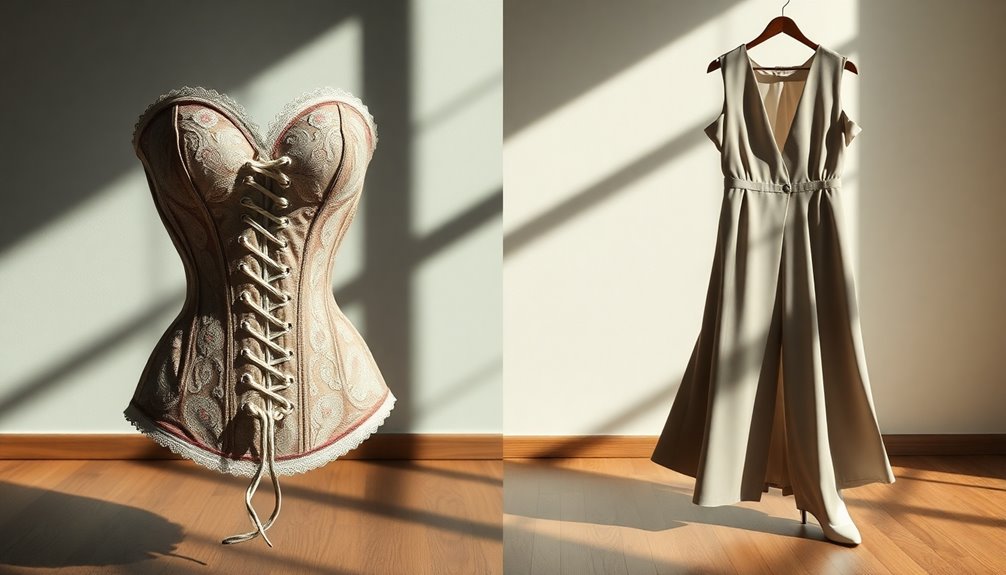
Fashion's evolution has always been intertwined with economic conditions, shaping what you wear based on affordability and practicality. When budgets are tight, your style reflects those constraints, often leaning towards durable and versatile pieces.
For instance, during economic downturns, trends shift to:
- Timeless basics: Simple, classic items that stand the test of time.
- Sustainable fashion: Eco-friendly choices that prioritize longevity over fast trends.
- Thrift shopping: Embracing second-hand finds that save money while offering unique styles.
As economies fluctuate, so do your fashion choices, emphasizing the importance of adapting to what's available.
The Impact of Cultural Shifts
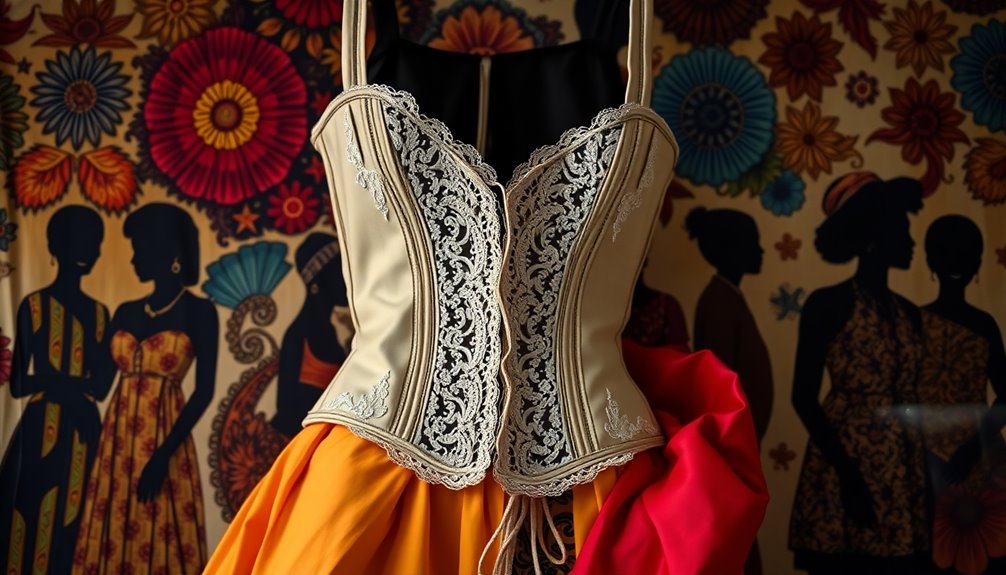
Cultural shifts have consistently reshaped how we express ourselves through clothing, reflecting broader societal changes. As you navigate through different eras, you'll notice how fashion mirrors movements like feminism and civil rights. For instance, the change from corsets to current styles highlights women's fight for autonomy. Furthermore, the evolution of fashion also parallels advancements in STEM education, which empowers individuals to embrace innovation and creativity. The importance of regular maintenance in automotive care can also serve as a metaphor for how we must continuously evolve and adapt our own styles to reflect our values and experiences. Engaging with educational toys can foster creativity and problem-solving skills that are mirrored in innovative fashion designs. Additionally, the intersection of fashion and sustainable practices showcases a commitment to ethical choices that resonate with modern consumers.
| Era | Fashion Trend | Cultural Influence |
|---|---|---|
| 1920s | Flapper dresses | Women's liberation |
| 1960s-70s | Miniskirts, pantsuits | Feminism and freedom |
| 1990s | Androgynous styles | Diversity and individuality |
These trends serve as markers of social progress, showing how clothing can embody personal and collective identities. Embrace the power of fashion to reflect your beliefs and experiences in today's evolving landscape. Furthermore, the rise of sustainable fashion emphasizes the growing demand for ethical production and conscious consumerism.
Dior's New Look Revolution
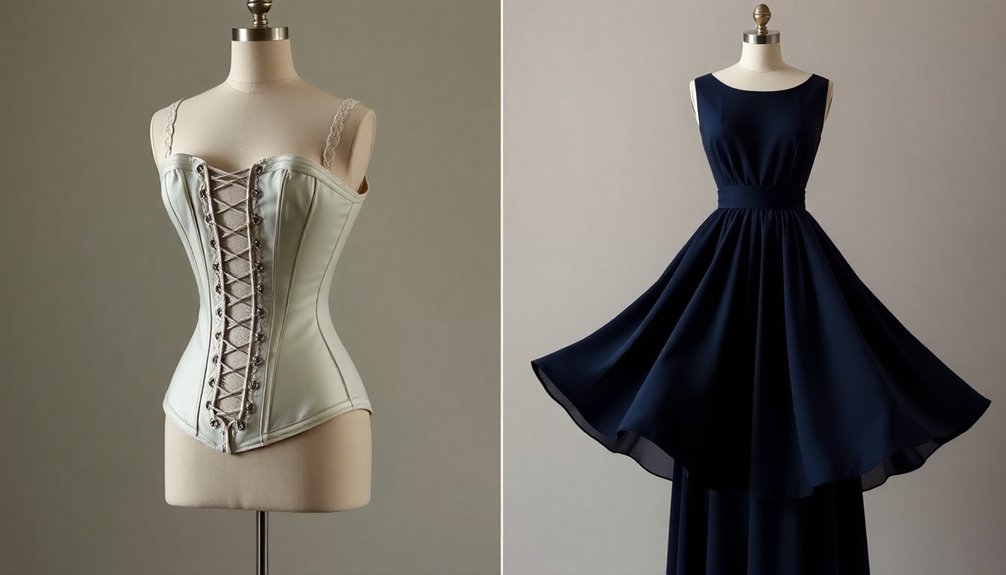
Emerging from the shadows of wartime austerity, Dior's New Look revolutionized women's fashion in 1947, bringing an unmistakable sense of femininity and luxury back to the forefront.
You'll notice the striking differences in silhouette and fabric that defined this era. The New Look brought forth:
- Rounded shoulders and a cinched waist to accentuate curves.
- Voluminous skirts that flowed elegantly, creating a sense of drama.
- Luxurious fabrics that celebrated abundance, contrasting starkly with the utilitarian styles of wartime.
This bold shift not only reinstated Paris as the fashion capital but also sparked debates on women's roles in society, highlighting both the allure of femininity and the push for independence.
Dior's vision reshaped the fashion landscape, leaving a lasting legacy.
Modern Interpretations of Fashion
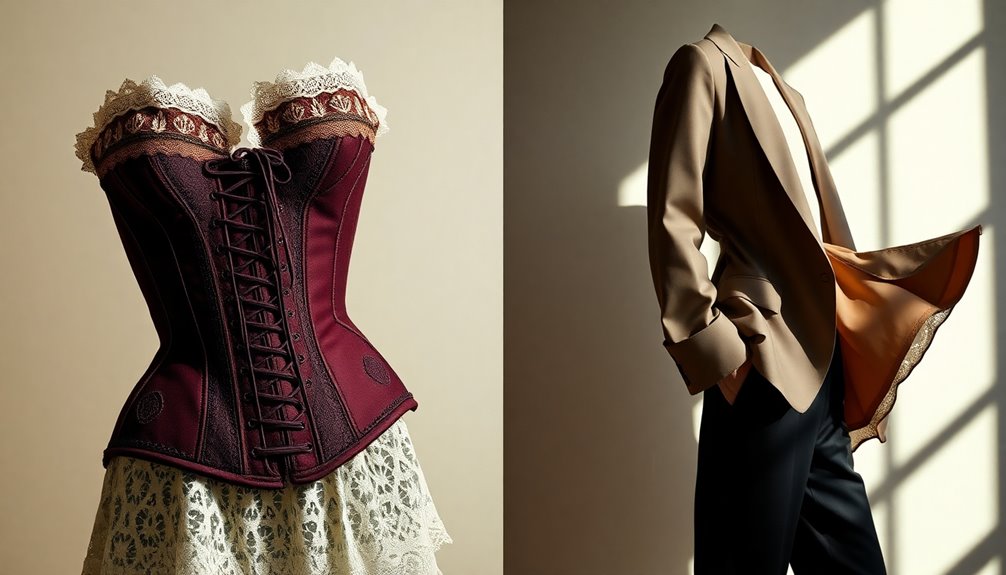
In today's fashion landscape, you can see a vibrant blend of historical influences and contemporary styles that challenge traditional norms. Designers merge past aesthetics with modern sensibilities, creating unique interpretations that resonate with diverse audiences. You might notice elements like oversized silhouettes, bold prints, and unexpected materials that push boundaries. These combinations reflect a society embracing individuality, comfort, and self-expression, making fashion a powerful medium for personal storytelling. Furthermore, the importance of support networks for new fathers is increasingly recognized in fashion campaigns that highlight the role of family and community in personal expression.
| Historical Influence | Modern Interpretation |
|---|---|
| Corsets | Structured bodices |
| Midi skirts | Asymmetrical hemlines |
| Victorian lace | Sheer layers and embellishments |
| 80s power suits | Gender-neutral tailoring |
| Bohemian styles | Eclectic mix of patterns |
Frequently Asked Questions
How Do Fashion Trends Reflect Current Societal Values and Issues?
Fashion trends mirror your values and societal issues, showing what matters to you and your community.
When you embrace eco-friendly brands, you're prioritizing sustainability and environmental awareness.
Trends like body positivity and inclusivity reflect shifts in how you perceive beauty and identity.
As you adopt styles that challenge norms, you advocate for equality and representation.
Ultimately, your clothing choices become a powerful expression of cultural movements and personal beliefs, shaping the world around you.
What Role Do Fashion Designers Play in Shaping Cultural Narratives?
You might think fashion designers just create clothes, but they actually play an essential role in shaping cultural narratives.
By interpreting societal issues and values, they influence how we express ourselves and challenge norms. Designers often use their platforms to address topics like body image, sustainability, and diversity.
When you wear a designer's creation, you're not just following a trend; you're participating in a broader conversation that reflects and impacts society.
How Has Technology Influenced Contemporary Fashion Production and Distribution?
Technology's reshaped contemporary fashion production and distribution in remarkable ways.
You've likely noticed how digital tools streamline design processes, enabling faster prototyping and customization. Online platforms allow you to shop globally, while social media influences trends and marketing strategies.
Additionally, advancements in sustainable materials and production techniques help you make more eco-conscious choices.
As a result, the fashion industry becomes more responsive to your preferences and the ever-evolving market demands.
What Impact Does Celebrity Culture Have on Fashion Trends Today?
Celebrity culture's like a powerful tide, shaping fashion trends with each ebb and flow. When you see your favorite stars donning a style, it sparks a desire to emulate that look.
Social media amplifies this influence, making trends go viral in an instant. You might find yourself reaching for clothes that mirror their choices, reflecting a deeper connection to their lifestyles.
Ultimately, this connection drives the fashion landscape, blending aspiration with everyday wear.
How Do Sustainability Concerns Affect Modern Fashion Choices?
Sustainability concerns are reshaping your fashion choices today.
You're increasingly drawn to brands that prioritize eco-friendly materials and ethical manufacturing practices. This shift encourages you to buy less but invest in higher quality pieces that last.
You might explore thrift stores or swap clothing with friends, embracing a more circular fashion approach.
Conclusion
As you reflect on fashion's journey from constricting corsets to the freedom of modern style, it's clear that clothing isn't just fabric—it's a powerful statement of identity and rebellion. Each stitch tells tales of women's relentless pursuit of independence and self-expression. Imagine how today's outfits, born from centuries of struggle, could spark revolutions! Fashion doesn't just change wardrobes; it transforms lives, igniting movements that ripple through time, proving that every garment can be a catalyst for change.
